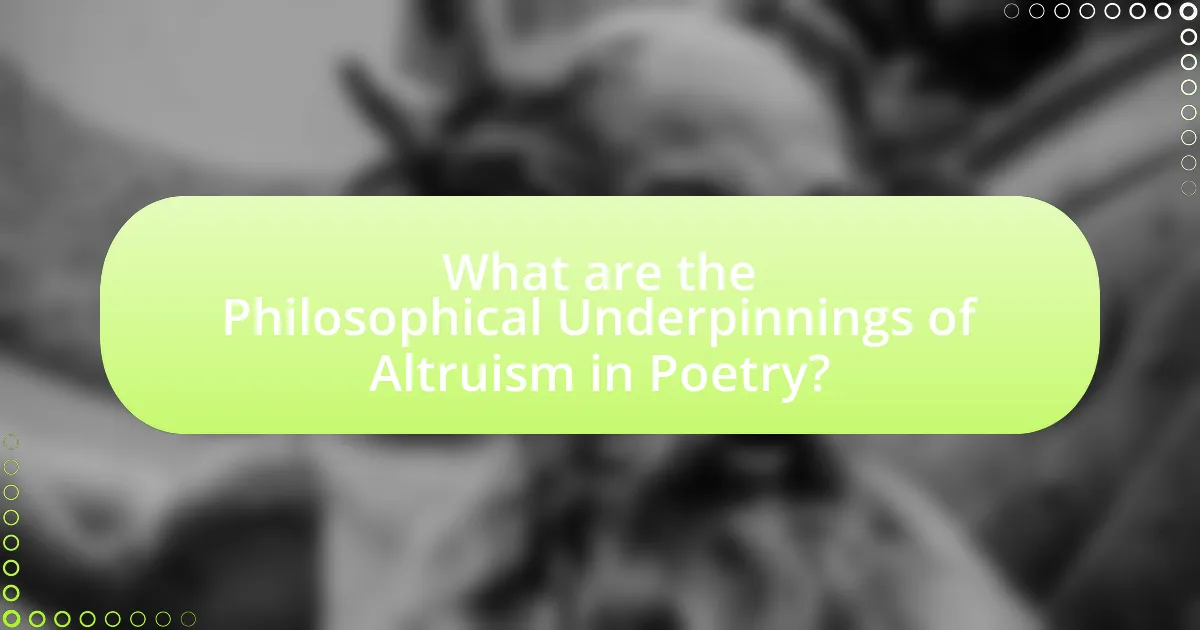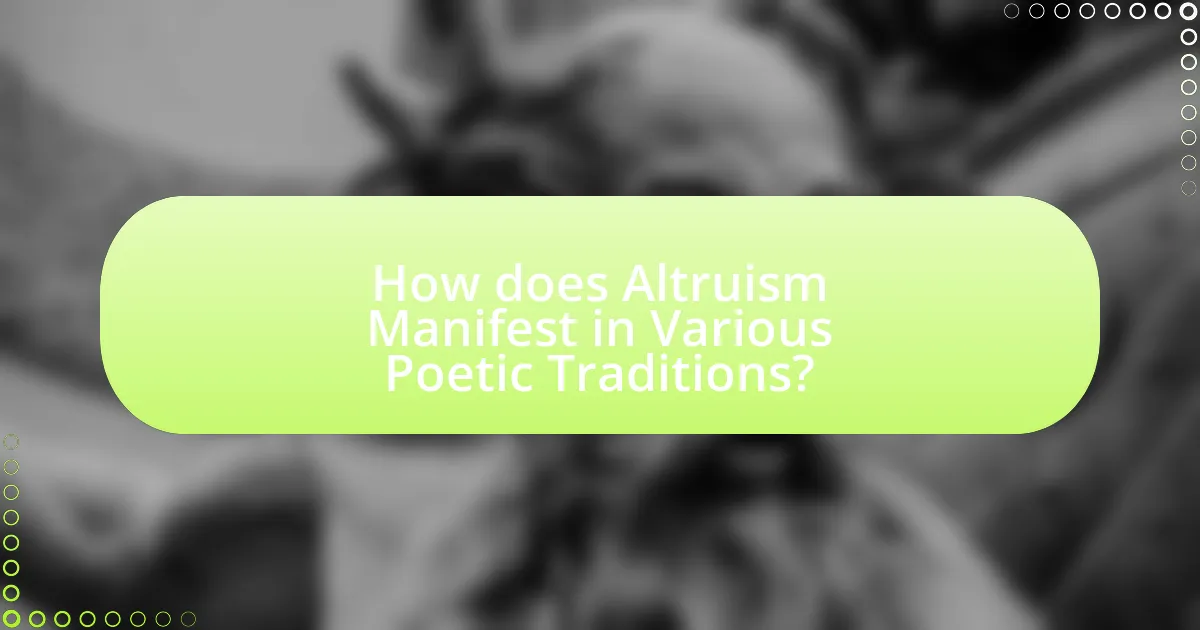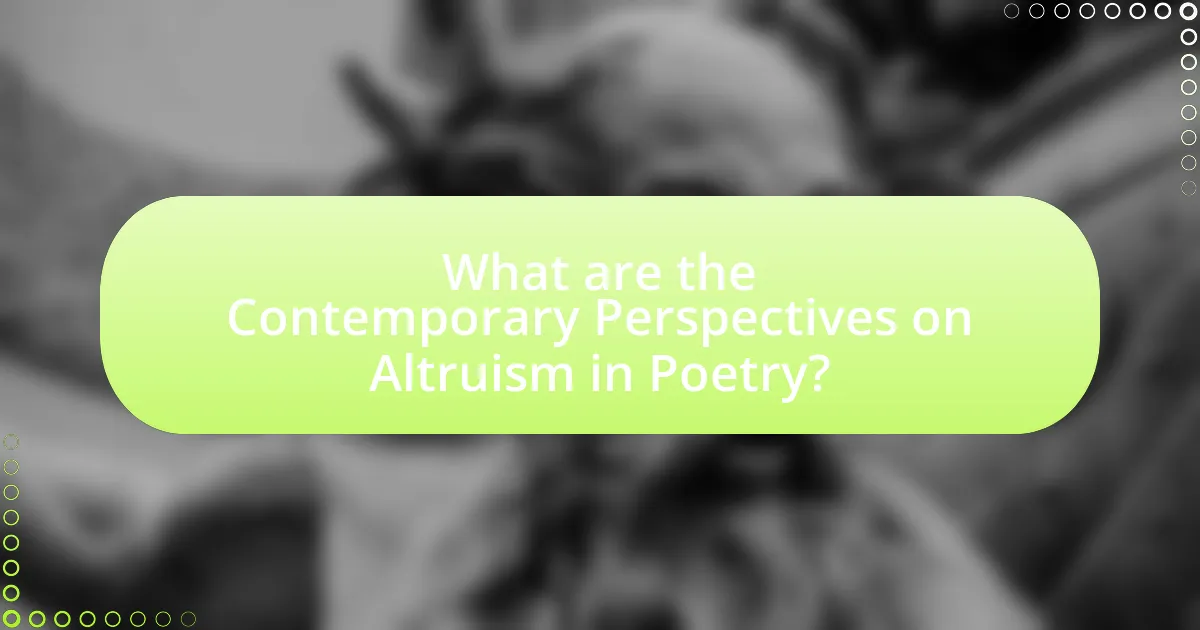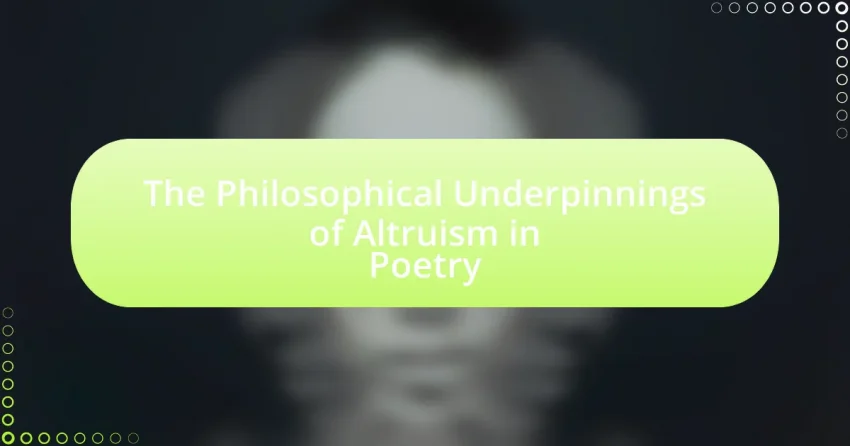The article examines the philosophical foundations of altruism in poetry, highlighting its ethical implications and the influence of various philosophical theories such as utilitarianism and Kantian ethics. It explores how poets like John Keats and Walt Whitman embody altruistic themes, emphasizing the interconnectedness of humanity and the moral obligation to care for others. Additionally, the article discusses the impact of historical contexts, social movements, and contemporary issues on the portrayal of altruism in poetry, as well as the techniques poets use to convey these themes effectively. Through this analysis, the article underscores the significance of altruism in enriching poetic expression and fostering empathy among readers.

What are the Philosophical Underpinnings of Altruism in Poetry?
The philosophical underpinnings of altruism in poetry center on the exploration of selflessness and the moral obligation to care for others. Altruism in poetry often reflects ethical theories such as utilitarianism, which posits that actions are right if they promote the greatest happiness for the greatest number, and Kantian ethics, which emphasizes duty and the intrinsic value of treating others as ends in themselves. Poets like John Keats and Walt Whitman exemplify this through their works, which advocate for empathy and connection among individuals. For instance, Whitman’s “Song of Myself” illustrates a profound sense of unity and shared experience, reinforcing the idea that individual well-being is intertwined with the well-being of others. This philosophical framework not only enriches the thematic depth of poetry but also encourages readers to engage in altruistic behavior in their own lives.
How do different philosophical theories define altruism?
Different philosophical theories define altruism in distinct ways, reflecting their underlying ethical frameworks. Utilitarianism views altruism as actions that maximize overall happiness or well-being for the greatest number of people, emphasizing the consequences of actions. In contrast, Kantian ethics defines altruism as a moral duty to act out of respect for others, prioritizing intentions over outcomes. Virtue ethics, on the other hand, sees altruism as a character trait that embodies virtues like compassion and generosity, focusing on the moral agent’s character rather than specific actions or consequences. Each of these theories provides a unique lens through which to understand altruism, highlighting its complexity in moral philosophy.
What role does ethics play in the concept of altruism?
Ethics serves as the foundational framework for understanding altruism, guiding the moral principles that dictate selfless behavior towards others. In the context of altruism, ethical theories such as utilitarianism and deontology provide criteria for evaluating actions based on their consequences or adherence to moral duties, respectively. For instance, utilitarianism posits that actions are morally right if they promote the greatest happiness for the greatest number, thereby justifying altruistic acts that benefit others. Conversely, deontological ethics emphasizes the intrinsic value of duty and intention, suggesting that altruism is morally commendable when motivated by a sense of obligation to help others. This ethical grounding is essential for distinguishing genuine altruism from self-serving behavior, as it underscores the importance of intention and moral responsibility in altruistic actions.
How do existentialist views influence the understanding of altruism in poetry?
Existentialist views influence the understanding of altruism in poetry by emphasizing individual choice and the inherent meaninglessness of life, which can lead to a deeper exploration of selfless acts. Existentialist thinkers like Jean-Paul Sartre and Simone de Beauvoir argue that individuals create their own essence through actions, suggesting that altruism is a conscious choice rather than an inherent trait. This perspective allows poets to depict altruism as a deliberate act of defiance against existential despair, showcasing characters who find purpose in helping others despite the absurdity of existence. For instance, in the works of poets such as Rainer Maria Rilke, altruism is portrayed as a means of transcending isolation and affirming one’s existence through connection with others. This alignment of existentialism with altruism in poetry highlights the transformative power of selfless actions in a seemingly indifferent universe.
Why is altruism significant in poetic expression?
Altruism is significant in poetic expression because it embodies the selfless concern for the well-being of others, which can evoke deep emotional resonance and foster a sense of connection among readers. This connection is crucial in poetry, as it allows poets to explore themes of empathy, compassion, and shared human experience. For instance, poets like John Keats and Walt Whitman have utilized altruistic themes to highlight the interconnectedness of humanity, demonstrating how acts of kindness and understanding can transcend individual experiences. The exploration of altruism in poetry not only enriches the emotional depth of the work but also encourages readers to reflect on their own values and relationships, reinforcing the idea that poetry can serve as a medium for social and moral reflection.
How does altruism shape the themes and messages in poetry?
Altruism significantly shapes the themes and messages in poetry by emphasizing selflessness and the interconnectedness of human experiences. Poets often explore the idea of sacrificing personal desires for the benefit of others, which fosters a sense of community and compassion. For instance, works like John Donne’s “No Man is an Island” illustrate how individual well-being is tied to the welfare of others, reinforcing the notion that altruistic actions contribute to a collective human experience. This thematic focus not only highlights moral values but also encourages readers to reflect on their own responsibilities towards others, thereby deepening the emotional resonance of the poetry.
What impact does altruism have on the reader’s interpretation of poetry?
Altruism significantly influences the reader’s interpretation of poetry by fostering empathy and emotional connection. When readers approach poetry with an altruistic mindset, they are more likely to engage with the themes and emotions presented, allowing for a deeper understanding of the poet’s intent and the human experience depicted. Research indicates that empathetic engagement enhances literary appreciation, as seen in studies where readers who practiced altruism reported a greater emotional response to poetic works. This connection not only enriches the reading experience but also encourages readers to reflect on their own values and relationships, ultimately shaping their interpretation of the text.

How does Altruism Manifest in Various Poetic Traditions?
Altruism manifests in various poetic traditions through themes of selflessness, compassion, and the interconnectedness of humanity. In Western poetry, for instance, works by poets like John Donne emphasize the idea that “no man is an island,” highlighting the importance of community and mutual support. Similarly, in Eastern traditions, such as in the poetry of the Buddha, altruism is expressed through the concept of compassion for all living beings, advocating for a life dedicated to the welfare of others. Furthermore, the Romantic poets, including Wordsworth and Coleridge, often portrayed nature as a shared experience that fosters empathy and altruistic feelings among individuals. These examples illustrate how different poetic traditions articulate altruistic values, reinforcing the notion that poetry serves as a medium for exploring and promoting selfless love and care for others.
What are the key characteristics of altruistic poetry across cultures?
Altruistic poetry across cultures is characterized by themes of selflessness, compassion, and a focus on the well-being of others. This type of poetry often emphasizes the interconnectedness of humanity, highlighting the importance of empathy and social responsibility. For instance, in various traditions, such as the works of Rumi in Persian literature or the poetry of Walt Whitman in American literature, the expression of love and care for others is central. These poets convey messages that encourage readers to transcend individual concerns and engage in acts of kindness and support for the community. Additionally, altruistic poetry frequently employs vivid imagery and emotional language to evoke feelings of solidarity and collective human experience, reinforcing the idea that personal fulfillment is linked to the welfare of others.
How do Eastern philosophies influence altruism in poetry?
Eastern philosophies significantly influence altruism in poetry by emphasizing interconnectedness and compassion. For instance, Buddhist teachings advocate for the concept of “metta,” or loving-kindness, which encourages poets to express empathy and selflessness in their work. This is evident in the poetry of writers like Li Bai, whose verses often reflect a deep sense of harmony with nature and humanity, illustrating the belief that individual well-being is tied to the well-being of others. Additionally, Confucianism promotes the idea of “ren,” or humaneness, which inspires poets to explore themes of moral duty and social responsibility, further embedding altruistic values into their literary expressions. These philosophical foundations create a rich tapestry of altruistic themes in Eastern poetry, reinforcing the notion that art can serve as a vehicle for promoting compassion and understanding among individuals.
What examples of altruism can be found in Western poetic traditions?
Examples of altruism in Western poetic traditions include John Donne’s “No Man is an Island,” which emphasizes the interconnectedness of humanity and the importance of selflessness, and Walt Whitman’s “Song of Myself,” where the poet expresses a deep empathy for others and a commitment to collective well-being. These works illustrate the philosophical notion that individual identity is tied to the larger community, reinforcing the idea that acts of kindness and compassion are essential to human experience. Donne’s assertion that the loss of one person diminishes all reflects a profound understanding of shared humanity, while Whitman’s celebration of diverse voices underscores the value of altruistic love and solidarity.
How do historical contexts shape the portrayal of altruism in poetry?
Historical contexts significantly shape the portrayal of altruism in poetry by influencing the themes, language, and perspectives poets adopt. For instance, during the Romantic era, poets like William Wordsworth emphasized nature and individual emotion, reflecting a growing belief in the inherent goodness of humanity and the importance of selfless acts. In contrast, the World War I era saw poets such as Wilfred Owen depict altruism through the lens of sacrifice and the harsh realities of war, highlighting the complexities of human compassion amidst suffering. These historical influences demonstrate how societal values and events directly inform poetic expressions of altruism, making the portrayal of selflessness a reflection of the times in which the poets lived.
What role did social movements play in the evolution of altruistic themes in poetry?
Social movements significantly influenced the evolution of altruistic themes in poetry by providing a platform for marginalized voices and social justice issues. For instance, the abolitionist movement in the 19th century inspired poets like Walt Whitman and Emily Dickinson to address themes of equality and human rights, reflecting the societal push for change. Similarly, the civil rights movement of the 1960s led to powerful poetic expressions from figures such as Maya Angelou and Gwendolyn Brooks, who articulated the struggles and aspirations of African Americans, emphasizing solidarity and compassion. These movements not only shaped the content of poetry but also expanded its reach, allowing poets to engage with broader audiences and inspire collective action.
How have major historical events influenced poets’ expressions of altruism?
Major historical events have significantly influenced poets’ expressions of altruism by shaping their themes, motivations, and perspectives. For instance, during the World Wars, poets like Wilfred Owen and Siegfried Sassoon highlighted the horrors of war and the need for compassion towards suffering individuals, reflecting a deep sense of altruism in their works. The civil rights movement inspired poets such as Maya Angelou and Langston Hughes to advocate for social justice and equality, emphasizing the importance of collective humanity and empathy. These historical contexts prompted poets to respond to societal issues, using their art to promote altruistic values and encourage societal change.

What are the Contemporary Perspectives on Altruism in Poetry?
Contemporary perspectives on altruism in poetry emphasize the interconnectedness of human experiences and the ethical responsibility of poets to address social issues. Many modern poets, such as Claudia Rankine and Ocean Vuong, explore themes of empathy, compassion, and social justice, reflecting a shift towards using poetry as a medium for activism. This aligns with the broader philosophical discourse that views altruism not merely as selfless acts but as a fundamental aspect of human relationships and societal progress. For instance, Rankine’s work often highlights racial injustices, prompting readers to engage with the lived experiences of marginalized communities, thereby fostering a sense of collective responsibility.
How do modern poets interpret altruism in their works?
Modern poets interpret altruism as a profound expression of human connection and empathy, often highlighting the importance of selflessness in personal and societal contexts. For instance, poets like Mary Oliver and Pablo Neruda explore themes of compassion and the interconnectedness of all beings, illustrating how acts of kindness can transcend individual experiences and foster community. Their works often reflect a philosophical stance that values altruism as essential for personal fulfillment and social harmony, reinforcing the idea that selfless actions contribute to a greater collective good. This interpretation is supported by the prevalence of altruistic themes in contemporary poetry, which often serves as a call to action for readers to engage in acts of kindness and solidarity.
What themes of altruism are prevalent in contemporary poetry?
Contemporary poetry frequently explores themes of empathy, social justice, and community support as expressions of altruism. Poets often highlight the interconnectedness of human experiences, emphasizing the importance of understanding and sharing in the struggles of others. For instance, works by poets like Claudia Rankine and Ocean Vuong address racial and cultural injustices, fostering a sense of collective responsibility and compassion. Additionally, themes of selflessness and the act of giving without expectation of return are prevalent, as seen in the poetry of Mary Oliver, who often reflects on nature and the importance of caring for the environment and each other. These themes underscore a philosophical commitment to altruism, illustrating how contemporary poetry serves as a medium for advocating kindness and social awareness.
How do modern societal issues influence the portrayal of altruism in poetry?
Modern societal issues significantly influence the portrayal of altruism in poetry by reflecting contemporary challenges such as inequality, climate change, and social justice. Poets often address these issues to highlight the need for collective action and empathy, showcasing altruism as a response to societal crises. For instance, the rise of movements like Black Lives Matter and climate activism has led poets to explore themes of solidarity and selflessness, emphasizing the importance of altruistic behavior in fostering community resilience. This connection is evident in works that respond to specific events, such as the COVID-19 pandemic, where poets have celebrated acts of kindness and sacrifice, reinforcing the idea that altruism is essential for societal healing and progress.
What challenges do poets face when addressing altruism today?
Poets today face the challenge of conveying altruism in a world increasingly focused on individualism and self-interest. This societal shift makes it difficult for poets to resonate with audiences who may prioritize personal gain over collective well-being. Additionally, the complexity of modern issues, such as climate change and social injustice, requires poets to navigate nuanced themes that can dilute the straightforward message of altruism. The rise of digital media also presents a challenge, as poets must compete for attention in a saturated market, often leading to oversimplification of altruistic themes to attract readers.
How do critics perceive the sincerity of altruistic themes in modern poetry?
Critics often perceive the sincerity of altruistic themes in modern poetry as a complex interplay between genuine intent and performative expression. Many argue that while some poets authentically engage with altruistic ideals, others may exploit these themes for personal or commercial gain, leading to skepticism about their true motivations. For instance, the rise of social media has prompted discussions about the authenticity of poets who address social issues, with critics noting that the visibility and virality of such works can sometimes overshadow their depth and sincerity. This duality is reflected in the works of poets like Claudia Rankine and Ocean Vuong, who are praised for their heartfelt explorations of empathy and social justice, yet also face scrutiny regarding the commodification of their messages in a market-driven literary landscape.
What are the potential pitfalls of writing about altruism in contemporary contexts?
Writing about altruism in contemporary contexts can lead to several pitfalls, including oversimplification, misinterpretation, and cultural insensitivity. Oversimplification occurs when complex motivations behind altruistic actions are reduced to mere selflessness, ignoring psychological and social factors that influence behavior. Misinterpretation can arise from projecting contemporary values onto historical or cultural practices of altruism, leading to inaccurate conclusions about their significance. Cultural insensitivity may manifest when writers fail to consider the diverse meanings of altruism across different societies, potentially alienating audiences or perpetuating stereotypes. These pitfalls highlight the need for nuanced and context-aware discussions of altruism in modern discourse.
What practical insights can be drawn from the study of altruism in poetry?
The study of altruism in poetry reveals that literature can foster empathy and social connection among readers. By exploring themes of selflessness and compassion, poetry encourages individuals to reflect on their own values and behaviors, promoting a culture of kindness. For instance, poems that depict acts of generosity can inspire readers to engage in altruistic behaviors themselves, as evidenced by research indicating that exposure to altruistic narratives can increase prosocial behavior in real life. This connection between poetry and altruism highlights the potential of literary art to influence moral development and community cohesion.
How can understanding altruism enhance one’s appreciation of poetry?
Understanding altruism can enhance one’s appreciation of poetry by fostering a deeper connection to the themes of empathy and selflessness often explored in poetic works. Poetry frequently reflects human experiences and emotions, and recognizing altruistic motivations allows readers to engage more profoundly with the poet’s intent and the emotional resonance of the text. For instance, poems that depict acts of kindness or sacrifice can evoke a stronger emotional response when readers understand the underlying altruistic principles, as seen in works like “The Gift” by William Carlos Williams, which illustrates the beauty of giving. This connection between altruism and poetry enriches the reader’s experience, enabling them to appreciate the nuances of human relationships and moral dilemmas presented in the art form.
What techniques can poets use to effectively convey altruistic themes?
Poets can effectively convey altruistic themes through techniques such as imagery, metaphor, and narrative voice. Imagery allows poets to create vivid pictures that evoke empathy and compassion, making the reader feel the emotions associated with altruistic actions. For instance, in Maya Angelou’s “Still I Rise,” the imagery of resilience highlights the strength found in helping others. Metaphors can deepen understanding by comparing altruism to universal experiences, as seen in John Donne’s “No Man Is an Island,” where he illustrates interconnectedness among humanity. Additionally, a compassionate narrative voice can engage readers, drawing them into the emotional landscape of altruism, as demonstrated in the works of Pablo Neruda, who often speaks directly to the collective human experience. These techniques not only enhance the emotional impact of the poetry but also reinforce the philosophical underpinnings of altruism by fostering a sense of shared humanity.
